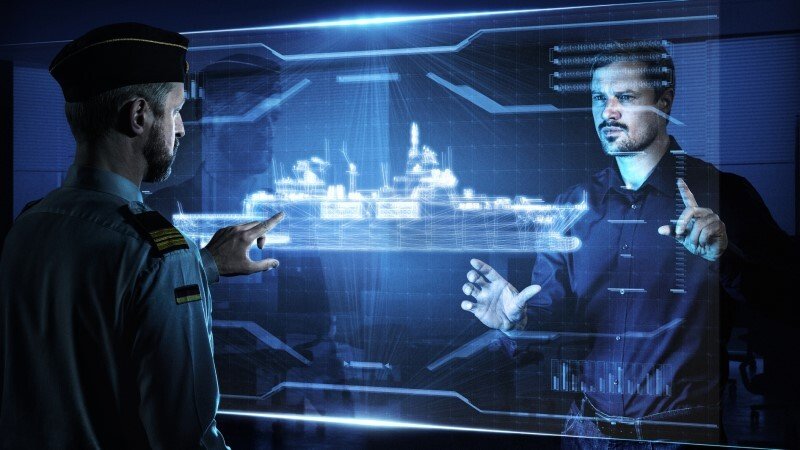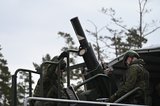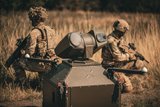Communications and ES measures on board for strategic advantages (Sponsored)
This article is brought to you by Rohde & Schwarz
New technological developments
The world is currently watching the latest conflicts in concern and it is forcing us to learn and to adapt.
So far, we have managed to realize that major changes in modern warfare have moved in three directions. Here it is important to say that this latest conflict has shown that tactics employed during any conflict in the 20th century are still valid and are being used.
As a rule, all mayor conflicts in the last decade have proven that most doctrine developed during peacetime is very soon superseded by “workarounds,” created by opposing factions. It is this art of adaptation and the need to counteract it, that has helped defense technology to jump forward drastically during times of conflict. At the same time, cultural liberalization influences behavior on the battlefield. In modern society, people refuse to be used for the front lines, as it was the case, e.g. during the Napoleonic wars or WWI. The value of an individual’s life is at an all-time high.
Unmanned systems
As mentioned above, major changes in modern warfare have moved in three directions. The first of these technological developments is a shift towards unmanned systems, which results in force protection and the ability to project force in a completely new manner. These unmanned assets can be weaponized, used for reconnaissance and/or as a flexible way of augmenting ad-hoc communication networks.

Human behavior
The second shift is related to human behavior and expectation on and off the battlefield. Today’ society is addicted to information and fully accustomed to having a wider picture of any given situation than absolutely necessary. It has been observed that when individuals are cut off from this kind of data overflow morale falls quickly and battle field stress becomes a risk. Information superiority must include a soldiers' private communications as well.
Information superiority
The third shift is a shift that was first observed in the 1990s. It is a shift towards information superiority by situational awareness. This comes as no surprise, as already Sun Tzu declared: “great leaders do not just gather information, they actively exploit and manipulate the assumptions of the other side.” This 2000-year-old wisdom has never been more true than today. Never has it been possible to learn so much about what one’s foe is doing as it is on the current battlefield. One only has to listen – Everything is alit!
Moving towards 6th generation defense technologies
As mentioned in the text above, after every major conflict, technologies evolve. Thus, NATO has begun talking about new requirements. These will lead to the creation of the sixth generation of technologies.
For communications, there is a demand for high data rate exchange, ad-hoc creation of multi-point links, and permanent cryptology running in the background. Situational awareness, information superiority, uninterrupted connectivity and robust and secure communications for military communications networks and information spaces for the entire chain of command and all branches of the armed forces are mandatory.

For electronic support systems, there is a rising demand for providing more information. Here, situational awareness to identify and locate threats and targets is key. Early and passive information gathering and preventive crisis management help to avoid conflicts and detect the adversary. Gaining information dominance through precise knowledge about enemy communications, positioning, strength and movements is paramount. Due to this, traditional electronic support requirements are enhanced by signals intelligence requirements.
Rohde & Schwarz, as a technology pioneer, is able to cover all requirements above. The independent and family-owned company develops, produces and markets a wide range of communications, electronic support and signals intelligence and security solutions, making an important contribution to a safer and connected world. Customers worldwide rely on Rohde & Schwarz and its cutting-edge innovations. In addition to its established business fields, the independent, privately owned company has made substantial investments in future technologies such as artificial intelligence, the industrial internet of things (IIoT), 6G, cloud solutions and quantum technology.
Rohde & Schwarz entered the field of electronic support measures from its vast experience in signals intelligence. The company’s solutions are fully capable of covering the enhanced requirements for intelligence collection and situational awareness provision. Rohde & Schwarz provides most sensitive and thereby very early warning electronic support solutions for radar and communication.
Rohde & Schwarz designs military communications networks and information spaces for the entire chain of command and all branches of the armed forces. The company’s products and solutions have proven their value in missions and applications around the globe.
Learn more here.
More from Industry Spotlights
-
![How are next-generation ejection seats helping pilots when they need it most?]()
How are next-generation ejection seats helping pilots when they need it most?
The ACES 5 ejection seat from RTX’s Collins Aerospace introduces new, innovative and patented technologies to help save lives.
-
How Patria TREMOS redefines battlefield mobility
The war in Ukraine has made it clear: the battlefield waits for no one. Military operations now take place in fast-paced environments, and speed is not just about the fight itself – it is about the entire ecosystem of warfare.
-
![“A new philosophy of defence”: ASELSAN sets out ambitions for the future]()
“A new philosophy of defence”: ASELSAN sets out ambitions for the future
In Conversation: Shephard’s Gerrard Cowan talks to ASELSAN CEO and President Ahmet Akyol about how the business has evolved and expanded over the past five decades, and its aim of becoming a top 30 global defence company by 2030.
-
![Levelling up – how autonomous fire control tackles unmanned lethality head-on]()
Levelling up – how autonomous fire control tackles unmanned lethality head-on
As autonomous weapon systems proliferate, it is now essential to use the same core technologies to counteract and neutralise them.
-
![Evolving for the future fight]()
Evolving for the future fight
Built on a 60-year heritage of providing the Department of Defense with solutions to dominate the electromagnetic spectrum.
-
![How AI and robotics drive innovation in land-based defence]()
How AI and robotics drive innovation in land-based defence
The future on the frontlines: automation and AI isn’t just about improving efficiency or driving down labour cost - for Pearson Engineering it’s everything.

























